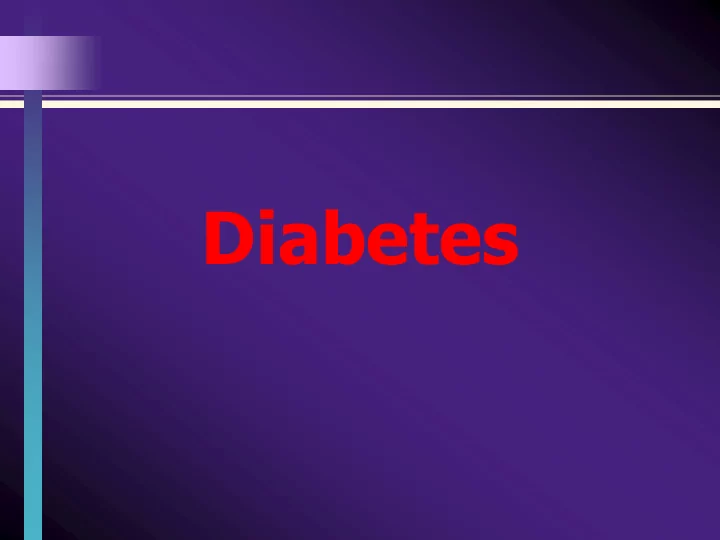

Diabetes
How things normally work When you eat, your body breaks food down into glucose. Glucose is a type of sugar that is your body’s main source of energy. 6
How things normally work As blood glucose rises, the body sends a signal to the pancreas, which releases insulin. 7
How things normally work Acting as a key, insulin binds to a place on the cell wall (an insulin receptor), unlocking the cell so glucose can pass into it. There, most of the glucose is used for energy right away. 7
Blood glucose regulation Blood glucose goes up and down throughout the day: As your blood glucose rises (after a meal), the pancreas releases insulin. 8
Type 2 diabetes Your pancreas may not produce enough insulin (insulin deficiency). Your cells don’t use insulin properly. The insulin can’t fully “unlock” the cells to allow glucose to enter 13 (insulin resistance).
Natural History of Diabetes Natural History of Type 2 Diabetes Obesity IGT * Diabetes Uncontrolled Hyperglycemia Post-Meal Glucose Plasma Glucose Fasting Glucose 120 (mg/dL) Relative -Cell Insulin Resistance Function 100 (%) Insulin Secretion -20 -10 0 10 20 30 Years of Diabetes *IGT = impaired glucose tolerance. Adapted from International Diabetes Center (IDC), Minneapolis, Minnesota.
Diagnosing diabetes Fasting plasma glucose test (FPG) results diabetes 126 mg/dL or greater 125 mg/dL to 100 mg/dL pre-diabetes normal less than 100 mg/dL 28
Risk factors for type 2 diabetes Type 2 is more common in people who: Are overweight. Are 45 or older. Are physically inactive. Have a parent or sibling with type 2 diabetes. Are African American, Native American, Hispanic American, or Pacific Islander. Have abnormal cholesterol levels. Have had gestational diabetes, or given birth to a baby greater than 9 lbs. 14 Have high blood pressure.
Hyperglycemia Can Cause Serious Long-Term Problems
Blood Glucose Targets for Adults Pre-meal or fasting : 80-120 2 hours post-meal: 80-140 Bedtime: 80-140 or 100-140
When & How Often Should I Be Testing? On insulin: 4 times per day. Not on insulin: 2 times per day.
Test at Alternating Times of the Day Before or 2 Hours After Eating Day of Breakfast Lunch Dinner Bedtime the week Mon. X X Tues. X X Wed. X X
Meal plan works like this Maximum CHO Breakfast Lunch Dinner
Meal plan works like this CHO CHO CHO Breakfast Lunch Dinner
Hypoglycemic Symptoms
How to care for yourself when you’re hypoglycemic Eat or drink 15 grams of fast-acting, low-fat carbohydrate right away. Quick energy sources The following items are quick energy sources that contain about 15 grams of carbohydrate: ½ cup fruit of orange, apple, or grapefruit juice 1/3 cup grape, prune, or cranberry juice 2 tbsp raisins 6 crackers 3-5 pieces hard candy 1 cup skim milk 1 piece bread 3-4 glucose tablets, or 1 tube glucose gel ½ cup regular soft drink (not diet) 96 11 jellybeans
HbA1c: the blood test with a memory What is HbA1c? Hemoglobin is a protein that makes your red blood cells red-colored. When hemoglobin picks up glucose from your bloodstream, the hemoglobin becomes glycosylated. Glycosylated hemoglobin is HbA1c. The HbA1c test measures the percentage of HbA1c in your blood — HbA1c in your bloodstream. a number that corresponds to your average blood glucose for the previous 3 months. 45
Introduction to self-management Key pieces of diabetes self-management: Following a Monitoring meal plan blood glucose Getting regular Taking exercise medication 34
Good News About Physical Activity
Can’t exercise? Pools Exercise balls or exercise bands Walking tape Stationary bikes Exercise videos Yoga Local Recreation Centers or school facilities TV Programs like: “ Sit and Be Fit ” M,W, F at 8:30AM on channel 9
Exercise is boring. Vary your routine and don’t be afraid to try something new. Participate in things you like to do. Exercise with a friend Use music or books on tape to make the time pass more quickly.
Tips for Safe Physical Activity
Long-Term Complications
Hyperglycemia Can Cause Serious Long-Term Problems
Diabetes-CVD Facts Nearly all adults with diabetes have one or more cholesterol problems, such as: – high triglycerides –low HDL (“good”) cholesterol –high LDL (“bad”) cholesterol 4
ABC’s A – A1c, or hemoglobin A1c test. ADA goal is 7% or less. AACE goal is 6.5% or less. B – Blood pressure < 130/80 mmHg for non-pregnant adults. C – Cholesterol HDL (good) cholesterol – >40 mg/dl (men); >50 mg/dl (women) LDL (bad) cholesterol – <100 mg/dl Triglycerides – <150 mg/dl
Good News for Type 1 Diabetes
Good News for Type 2 Diabetes
Take Steps to Reduce Risk Factors for Heart Disease
Aspirin Therapy Recommended dose: 81-325 mg /day Should not be used in people with: Aspirin allergies, a history of gastric bleeding, clotting disorders, or people already taking a blood-thinning agent.
Diabetes Can Lead to Nerve and Small Blood Vessel Damage
Getting regular medical care Schedule for routine medical care HbA1c 2-4 times/year Blood pressure At least 2 times/year Cholesterol At least every other year Dilated eye exam 1 time/year Foot exam At least 1 time/year Dental exam 2 times/year Urine microalbumin/ 1 time/year creatinine ratio Flu shot 1 time/year 76 Pneumococcal vaccine Once (repeat at age 65)
Find Diabetes Educators in Your Area
Organizations & websites National Diabetes Education Program Intermountain Health Care IHC Diabetes Management Program One Diabetes Way Phone: 1-800-442-5305 Bethesda, MD 20814-9692 www.ihc.com/diabetes Phone: 301-496-3583 www.ndep.nih.gov National Diabetes Information Clearinghouse Diabetes Exercise and Sports Association 1 Information Way 8001 Montcastle Dr. Bethesda, MD 20892-3560 Nashville, TN 37221 Phone: 1-800-860-8747 Phone: 1-800-898-4322 www.diabetes.niddk.nih.gov www.diabetes-exercise.org American Diabetes Association ATTN: National Call Center Juvenile Diabetes Research Foundation 1701 North Beauregard Street 120 Wall Street Alexandria, VA 22311 New York, NY 10005-4001 Phone: 1-800-DIABETES Phone: 1-800-533-CURE (2873) (1-800-342-2383) www.jdf.org www.diabetes.org Joslin Diabetes Center American Dietetic Association One Joslin Place 120 South Riverside Plaza, Boston, MA 02215 Suite 2000 Phone: 617-732-2400 Chicago, Illinois 60606-6995 105 Phone: 1-800-877-1600 www.joslin.org www.eatright.org
Recommend
More recommend